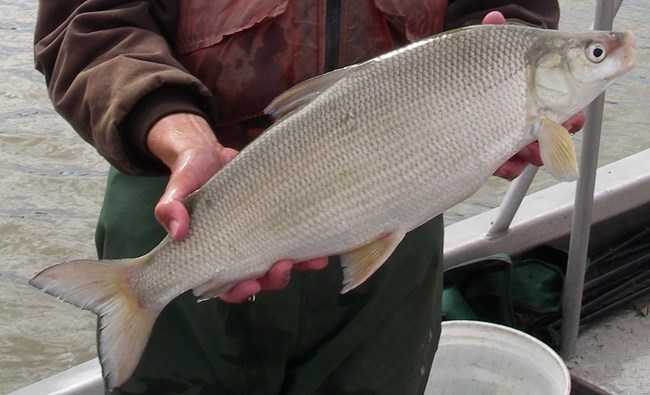
US Fish & Wildlife photo 
US Fish & Wildlife photo Early explorers were amazed by the rich fish population of the world's greatest lake. Up to 44 different species are known to exist within and around the Apostle Islands including recreationally and commercially important species such as lake trout, whitefish, lake sturgeon and smallmouth bass along with several other species many people may not be aware of such as the spoonhead sculpin, trout-perch or Johnny Darter. Historically, Native Americans and fur trappers fished for subsistence and trade. Later, in the 1870’s and 1880’s, commercial fishing became a major industry. Years of heavy fishing pressure, combined with extensive habitat degradation from forestry and agriculture, took a toll on fish populations. By the 1890’s the whitefish population crashed, and fishermen turned to lake trout and herring (cisco). Whitefish, aided by the state’s stocking program, recovered in the 1930’s. Then the most severe blow to Great Lakes fisheries came with the arrival of the sea lamprey. By the 1950's this parasitic species devastated much of the native fish population in the lower Great Lakes and impacted Lake Superior stocks of lake trout and whitefish. Intensive control efforts by both U.S. and Canadian governments succeeded in minimizing the havoc wrought by the sea lamprey in Lake Superior, and some fish populations have rebounded. When the Apostle Island National Lakeshore was established in 1970, some fish populations were at historic lows. Establishment of Refuges at Gull and Devils Island shoals (in 1976 and 1981, respectively) offered habitat protection for lake trout, and have been a great success story. Recent investigations show that the refuges, originally established to protect and help restore lake trout populations, have also resulted in increases to lake whitefish production and recruitment in the surrounding area. Lake trout, once on the verge of disappearance, and whitefish once again maintain viable populations in the cold, clear waters of Gichigami (Lake Superior) and support important commercial and recreational fisheries throughout the Apostle Islands area. 
NPS photo/J. Glase For more information: Great Lakes Fishery Commission - Lake Superior Committee Select a Park:Select a Species Category (optional):
Search results will be displayed here.

NPS photo/Pete Sweger |
Last updated: October 15, 2021
